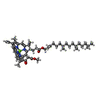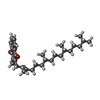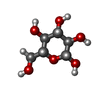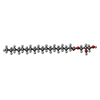+Search query
-Structure paper
| Title | Unique organization of photosystem I-light-harvesting supercomplex revealed by cryo-EM from a red alga. |
|---|---|
| Journal, issue, pages | Proc Natl Acad Sci U S A, Vol. 115, Issue 17, Page 4423-4428, Year 2018 |
| Publish date | Apr 24, 2018 |
 Authors Authors | Xiong Pi / Lirong Tian / Huai-En Dai / Xiaochun Qin / Lingpeng Cheng / Tingyun Kuang / Sen-Fang Sui / Jian-Ren Shen /   |
| PubMed Abstract | Photosystem I (PSI) is one of the two photosystems present in oxygenic photosynthetic organisms and functions to harvest and convert light energy into chemical energy in photosynthesis. In eukaryotic ...Photosystem I (PSI) is one of the two photosystems present in oxygenic photosynthetic organisms and functions to harvest and convert light energy into chemical energy in photosynthesis. In eukaryotic algae and higher plants, PSI consists of a core surrounded by variable species and numbers of light-harvesting complex (LHC)I proteins, forming a PSI-LHCI supercomplex. Here, we report cryo-EM structures of PSI-LHCR from the red alga in two forms, one with three Lhcr subunits attached to the side, similar to that of higher plants, and the other with two additional Lhcr subunits attached to the opposite side, indicating an ancient form of PSI-LHCI. Furthermore, the red algal PSI core showed features of both cyanobacterial and higher plant PSI, suggesting an intermediate type during evolution from prokaryotes to eukaryotes. The structure of PsaO, existing in eukaryotic organisms, was identified in the PSI core and binds three chlorophylls and may be important in harvesting energy and in mediating energy transfer from LHCII to the PSI core under state-2 conditions. Individual attaching sites of LHCRs with the core subunits were identified, and each Lhcr was found to contain 11 to 13 chlorophylls and 5 zeaxanthins, which are apparently different from those of LHCs in plant PSI-LHCI. Together, our results reveal unique energy transfer pathways different from those of higher plant PSI-LHCI, its adaptation to the changing environment, and the possible changes of PSI-LHCI during evolution from prokaryotes to eukaryotes. |
 External links External links |  Proc Natl Acad Sci U S A / Proc Natl Acad Sci U S A /  PubMed:29632169 / PubMed:29632169 /  PubMed Central PubMed Central |
| Methods | EM (single particle) |
| Resolution | 3.63 - 3.82 Å |
| Structure data | |
| Chemicals |  ChemComp-CL0:  ChemComp-CLA:  ChemComp-PQN:  ChemComp-LHG:  ChemComp-BCR:  ChemComp-SF4:  ChemComp-BGC:  ChemComp-DGD:  ChemComp-3XQ:  ChemComp-ZEX:  ChemComp-1DO: |
| Source |
|
 Keywords Keywords | PHOTOSYNTHESIS / super-complex / red alga / PSI-5Lhcr |
 Movie
Movie Controller
Controller Structure viewers
Structure viewers About Yorodumi Papers
About Yorodumi Papers







 Cyanidioschyzon merolae (eukaryote)
Cyanidioschyzon merolae (eukaryote)